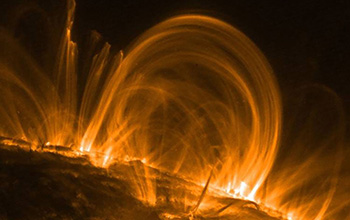New study challenges long-held assumptions about the structure of the sun's atmosphere

Coronal loops: A new study challenges long-held assumptions about the sun.
Many coronal loops -- ropey strands of plasma that scientists have long thought existed in the sun's atmosphere -- may be optical illusions, according to a new paper that challenges prevailing assumptions of what researchers know, and don't know, about the sun.
The study, led by scientists at the National Center for Atmospheric Research, or NCAR, and published in The Astrophysical Journal, relied on a cutting-edge, realistic 3D simulation of the solar corona. The simulation allowed the researchers to slice the corona in distinct sections to isolate individual coronal loops. The study was supported in part by the U.S. National Science Foundation.
What the scientists found is that many of the loops weren't loops at all. "This is an exciting and unexpected result that proposes an entirely new way of thinking about the sun's coronal loops," said Maria Womack, a program director in NSF's Division of Atmospheric and Geospace Sciences.
While the researchers were able to pinpoint some of the coronal loops they were looking for, they also found that in many cases what appear to be loops in images taken of the sun may be wrinkles of bright plasma in the solar atmosphere. As sheets of bright plasma fold over themselves, the folds look like bright thin lines, mimicking the look of distinct and self-contained strands of plasma.
The findings, which the team is calling the "coronal veil hypothesis," have significant implications for our understanding of the sun, since the presumed coronal loops have been used for decades to infer information about density, temperature and other physical characteristics of the solar atmosphere.
"I have spent my entire career studying coronal loops," said NCAR's High Altitude Observatory scientist Anna Malanushenko, who led the study. "This is an entirely new paradigm of understanding the sun's atmosphere."






